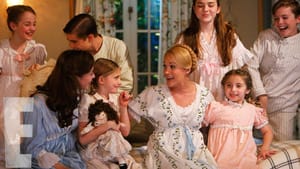Stay in the Loop
BSR publishes on a weekly schedule, with an email newsletter every Wednesday and Thursday morning. There’s no paywall, and subscribing is always free.
Carrie Underwood confronts the Maria problem
Carrie Underwood vs. Julie Andrews

Back in 1959, my parents were invited to invest in a Broadway musical called First Impressions, an adaptation of Jane Austen’s Pride and Prejudice starring Giselle MacKenzie as Elizabeth Bennet, Hermione Gingold as Mrs. Bennet and Farley Granger as Mr. Darcy. How could it fail? Well, to start, MacKenzie dropped out of the show and Polly Bergen replaced her. Other obstacles apparently surfaced as well. While we got to attend opening night, the show lasted only 84 performances and vanished into the recesses of memory.
However, that same opening night my parents received an offer to invest in another little musical in the works, starring Mary Martin and the then-popular folk-singer Theodore Bikel— yes, The Sound of Music. Despite my pleas, my parents, spooked by having lost money on their first venture into show business, turned it down. So I remember it well.
When the 1965 movie of The Sound of Music (starring Julie Andrews and Christopher Plummer), most people hadn’t seen the Broadway original and accepted Andrews as Maria— then and forever after.
Andrews vs. Hepburn
Curiously, Andrews had scored a Broadway hit in 1956 as Eliza Doolittle in My Fair Lady, but when the show was adapted for film in 1964 she was passed over in favor of Audrey Hepburn because Hollywood producers didn’t consider her a bankable star. (Hepburn’s songs were dubbed by Marni Nixon.) In Camelot, the role of Guinevere, which Andrews played on stage opposite Richard Burton, was played on film by Vanessa Redgrave opposite Richard Harris (although in that case, the reason was said to be Andrews’s busy schedule).
Similarly, the role of another Maria— the lead in West Side Story was played by Carol Lawrence on stage and then on film by Natalie Wood, dubbed again by Marni Nixon. (Nixon, by the way, finally got credit under her own name for playing Sister Sophia in the film of The Sound of Music.)
Squeaky clean
So it was a gutsy move this month when Carrie Underwood— the country music darling who not only won the fourth season of “American Idol” back in 2005 but also turned into an award-winning, multi-platinum selling singing sensation— took on the role of Maria in NBC TV’s live presentation of The Sound of Music. The role belonged, in many viewers’ minds, to Julie Andrews.
What Underwood had going for her was a dynamite singing voice and a squeaky-clean reputation that matched the innocence of Maria, the novice who just didn’t belong in a convent. What Underwood had going against her was a lack of acting experience. And, let’s face it, she wasn’t Julie Andrews.
Which raises the question: Does a part belong to the original actress who played it? Or perhaps the one who played it best? And how do we deal with a change in our expectations when someone else takes on the role?
Clark Gable’s role
The popular BBC series “Doctor Who” has managed expectations by defining The Doctor as someone who regenerates, often into another form (so far not a woman or an animal, but who knows?). When he starts spewing golden light, we know that the next face to emerge from the glow will be— another Doctor. In other words, another actor, usually because the current Doctor wanted to move on to the next stage in his career.
But that wasn’t the case here. NBC-TV was clearly trying to appeal to a new and younger audience with a current fan favorite in a revival of what has become a holiday season classic.
Margaret Mitchell wrote Gone With The Wind with Clark Gable in mind for the role of Rhett Butler, and luckily he was available to play the part. But casting Scarlett O’Hara was another matter. Somehow, after an intensive search, the unlikely British actress Vivian Leigh was cast in the role. Now she’s identified with the part, and luckily no one has tried to remake the film.
Ronstadt’s breakout
More recently, we have watched and criticized as producers try to cast actors to match readers’ expectations of their favorite characters. Jennifer Lawrence as Katniss Everdeen in Suzanne Collins’s popular series, “The Hunger Games,” seems to have succeeded. The casting of Kristen Stewart as Bella Swan and Robert Pattison as Edward Cullen in the “Twilight” novels by Stephanie Meyer has been a bit more problematic. And soon we’ll have the Fifty Shades of Gray series to react to. The reality is that no matter how we may feel about a particular casting decision, once an actor or actress had been cast in a particular role, audiences tend to accept that person as the standard for the part.
We also have trouble accepting performers who take on new roles— TV stars on Broadway, actors making records. In 1984 I attended a performance of La Bohème at Joseph Papp’s Public Theater in New York, starring Linda Ronstadt as Mimi. When I noticed Placido Domingo seated in front of me, I mustered he courage to talk to him about the show. He was very supportive of Ronstadt's performance.
I mention this because Underwood’s performance now reminds me of Ronstadt’s then. Both are good singers in their own genres who took on roles that challenged them to perform out of their comfort zone. They worked hard to carry off a credible performance and surrounded themselves with professionals in the area they were exploring. Ronstadt never became an opera singer— and unfortunately her recent diagnosis of Parkinson’s means that she can no longer sing at all. Nevertheless, she showed that she could expand beyond just being rock ’n roll.
Flawed production
Carrie Underwood’s career is ahead of her, and her willingness to take risks means that she too isn’t limiting herself to country music. She may not set the standard for a new Maria, and the production suffered flaws beyond her performance— Stephen Moyer was a not very credible Captain, and Audra Macdonald’s performance as Mother Abbess blasted over the others so thoroughly that it made the production feel unbalanced. But Underwood has challenged us to take a look at classic characters with a new eye and opened the possibility that we might just learn something in the process.
Maybe the merging of role and performer is similar to trying to grasp a moonbeam. Remind me again— how do you hold a moonbeam in your hand?
What, When, Where
The Sound of Music Live! Music by Richard Rodgers; lyrics by Oscar Hammerstein II; book by Howard Lindsay and Russel Crouse. NBC-TV production December 5, 2013. www.nbc.com/sound-of-music.
Sign up for our newsletter
All of the week's new articles, all in one place. Sign up for the free weekly BSR newsletters, and don't miss a conversation.
 Naomi Orwin
Naomi Orwin